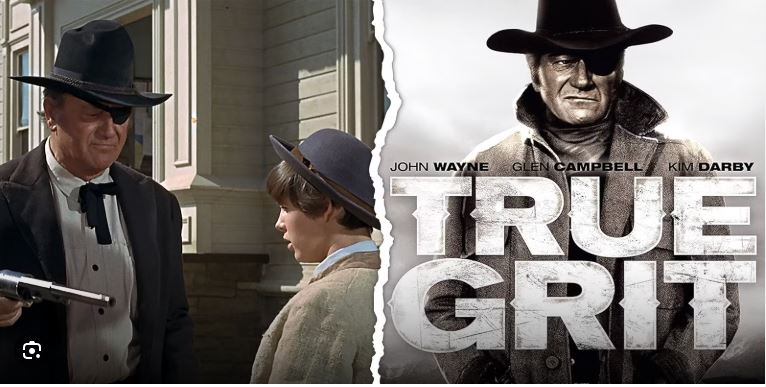The original True Grit builds to a single scene. John Wayne — as the craggy, veteran cowboy Rooster Cogburn — rides down a hill, shotgun in one hand, pistol in the other, the reigns of his horse clenched between his teeth. He charges forward, guns blazing, shooting four bad guys also on horseback to save the day. By 1969, audiences had become accustomed to seeing John Wayne as a cowboy hero saving the day. But True Grit, directed by Henry Hathaway, lionized Wayne’s image as a hero of cinema and showcased his charm as an actor.
It’s no wonder that Wayne picked up the 1969 Academy Award for Best Actor for his performance as Rooster. Sadly, this was the only win of his otherwise legendary movie career. True Grit also arrived at a key transition point in cinema, when the standard Hollywood fare of the classic era began to feel antiquated. Wayne’s Oscar win had a certain irony to it: though it awarded one of the screen’s most beloved stars, it also signaled the end of an era. By no fault of its own, True Grit felt dated almost as soon as it hit screens. Wayne’s Oscar win is likely the only reason it stands out in Hollywood history.
True Grit Was the Zenith of John Wayne’s Illustrious Acting Career
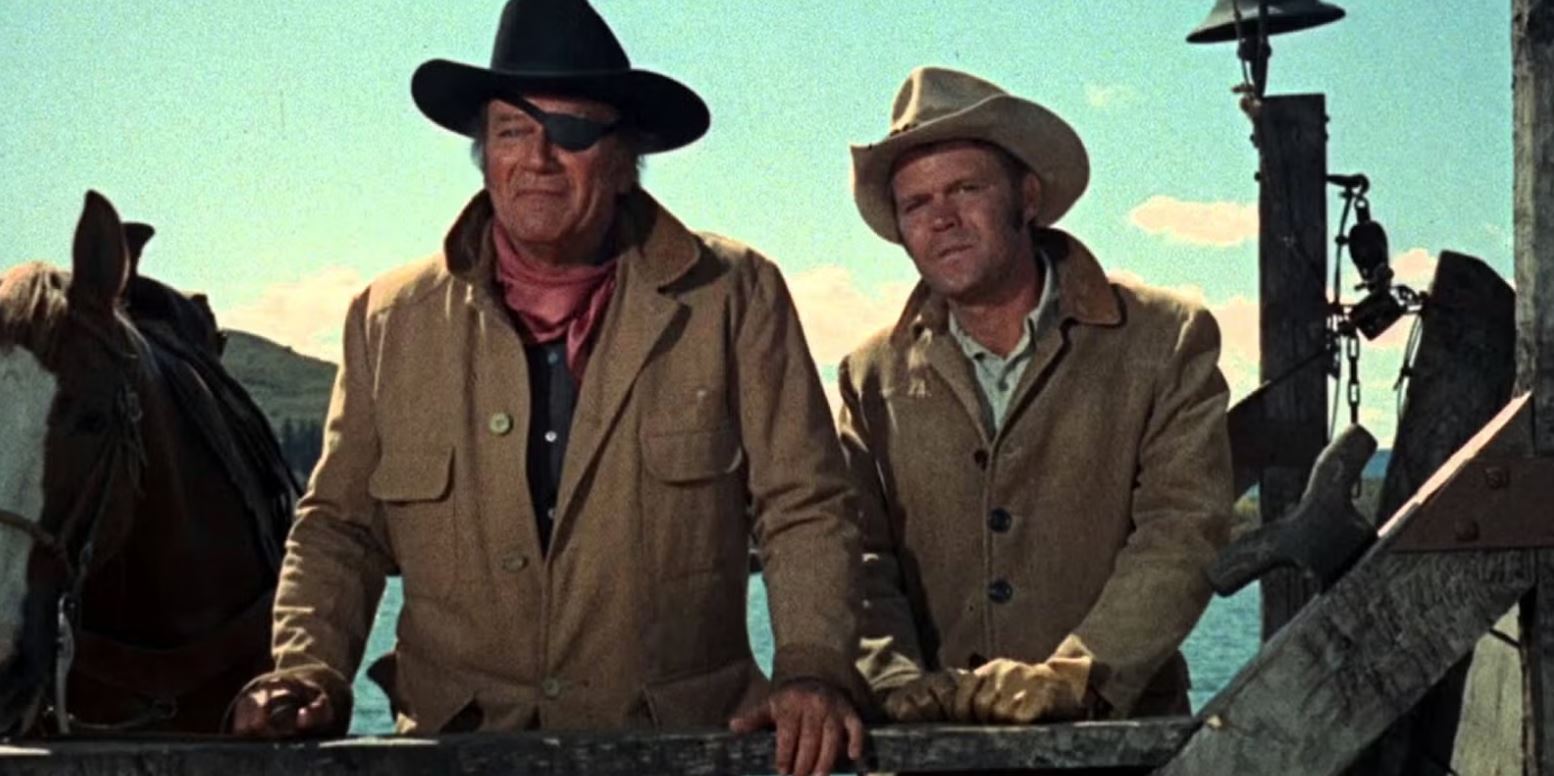
The Movie Gave the Cinematic Icon His Due
Wayne turned 62 in 1969, and though he had been appearing in movies since the silent era as a robust cowboy hero, his age had begun to show. Wayne had likely begun to feel his age too, which might be why Charles Portis’ novel, True Grit, sparked his attention. The actor had his eyes set on the role of Rooster Cogburn, a crusty old cowboy coot that becomes an escort to a young girl on a mission. Rooster reflected Wayne’s actual age and jaded mindset, making the one-eyed cowboy the perfect role for the veteran actor.
The plot picks up in 1880. Frank Ross, a middle-class landowner and father, is murdered by the drunkard Tom Cheney (Jeff Corey), leaving his family in mourning and his affairs in chaos. Ross’ teen daughter, Mattie (Kim Darby), resolves to settle her father’s affairs, and journeys to Indian territory (modern-day Oklahoma) in search of Cheney. If lawmen won’t capture him and bring him to justice, she will.
Mattie seeks out the help of Reuben “Rooster” Cogburn (Wayne), a grizzled, hard-drinking US Marshall. Cogburn first rejects Mattie’s pleas to help her find Cheney, but eventually accepts when she offers him considerable money. A handsome Texas Ranger named La Boeuf (folk singer Glen Campbell) also joins in the search. At first, Cogburn and La Boeuf refuse to let Matty join them on their trek. They change their minds after seeing her cleverness and tenacity in tracking them along Cheney’s trail.
The trio discovers that Cheney joined up with the outlaw Ned Pepper (Robert Duvall) and his gang, and set a trap to capture them. The plan hits a hitch, however, and Pepper and Cheney escape. One of Pepper’s gang members dies, and Cogburn again pleads with Mattie to leave the trail. Several days later, Mattie encounters Cheney near a riverbed. Mattie tries to shoot him, but her gun misfires. Pepper and Cheney take Mattie hostage, and Cogburn and La Boeuf seemingly abandon her.
Later, Pepper and his gang ride out, leaving Mattie with Cheney. La Boeuf rescues her, and the pair find Cogburn just in time to see him confront Pepper’s gang. Cogburn, with help from La Boeuf, kills Pepper and returns to deal with Cheney at their camp. Cheney attacks La Boeuf, killing him. Mattie shoots Cheney, but falls into a pit of rattlesnakes and injures her arm. Cogburn then manages to save the day, killing Cheney and rescuing Mattie. Mattie and Cogburn return to her home in Arkansas, where she promises that he’d be buried with her and her family when the time comes. Cogburn then rides off into the sunset as every cowboy that Wayne portrayed does, but not before cheekily disproving Mattie’s joke about him being too old and fat to ride a horse.
True Grit Played Up John Wayne’s Status as a Movie Star, For Better & Worse
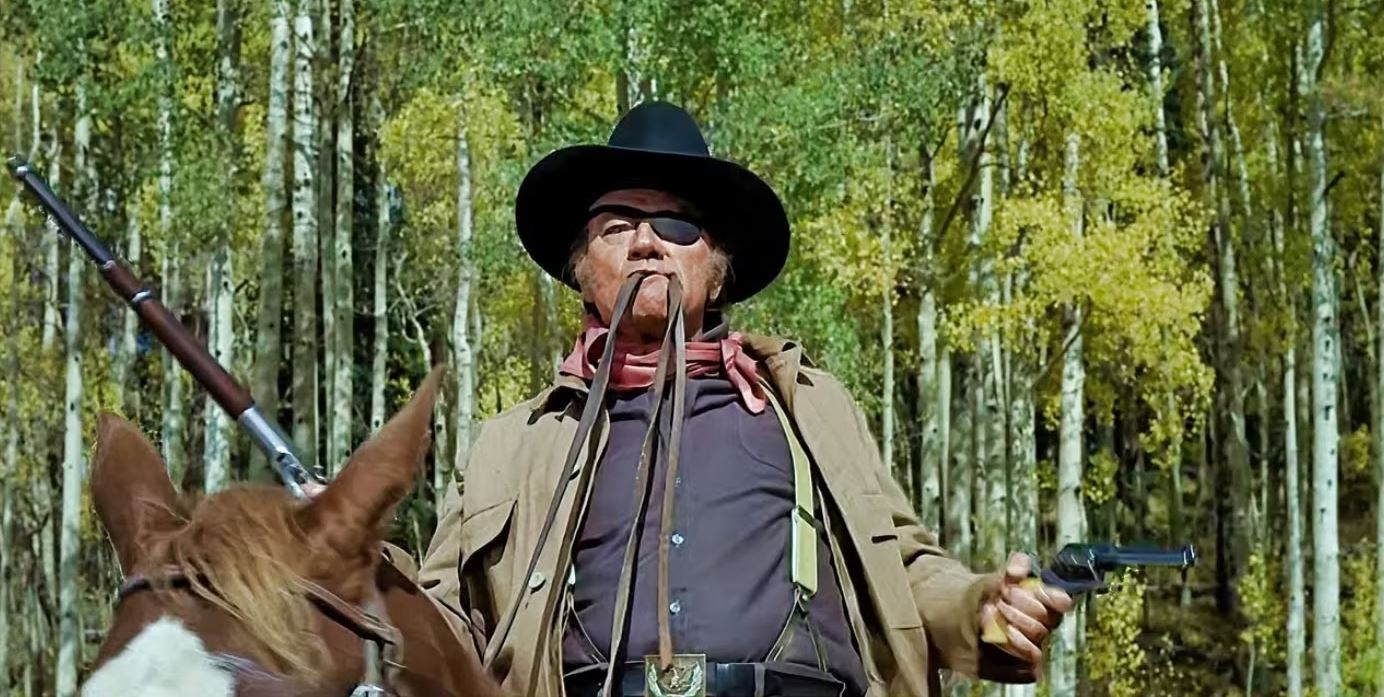
The Movie’s Supporting Cast Complemented John Wayne’s Strong Performance
Under Hathaway’s direction, True Grit tailors itself around Wayne, both for his abilities as an actor and for his on-screen persona. In fact, the movie’s final image is a freeze-frame of a triumphant Cogburn riding off into the sunset. In essence, Hathaway doesn’t just want the audience to celebrate the character saving the day. He wants to celebrate John Wayne, the All-American movie hero. The movie succeeds on that point, but at great cost to the overall story.
True Grit loses the essence of the novel, which is told entirely from Mattie’s point of view, and which has a much darker and, well, grittier tone than this film. As played by Darby, then 21-years-old, Mattie comes off more as a young woman than a child on the brink of adolescence. In a sense, this casting choice dilutes the character. Seeing a young woman riding through the West flanked by frontier lawmen makes an impression. Seeing a child show as much tenacity as Mattie and do the same things that Darby did in the 1969 movie leaves a much more dramatic mark. For reference, see how much more tense True Grit’s 2010 remake is than the 1969 classic. The remake’s Mattie, Hailee Steinfeld, was only 14-years-old at the time of filming.
That said, Darby does give the key performance in True Grit. For all Wayne’s swagger and Duvall’s malevolence, Darby grounds the movie, projecting intellect, cunning and determination as much as her older, male co-stars. In her own way, she gives a performance on par with Wayne’s, crafting a fully realized character capable of all the tough-and-rumble actions that her male counterparts take pride in. Darby would continue to work consistently after her turn in True Grit, though she never scored another plumb role. That speaks to the cruelty of showbiz.
It helps that True Grit’s other supporting players match Darby in her intensity. Duvall, as gang leader Ned Pepper, oozes evil. Campbell, despite a lack of acting experience, does a fine job as the pretty boy La Boeuf, playing his role with a wink and a smile. Corey, as Cheney, comes off less as a bloodthirsty murderer than a pathetic drunkard. In a sense, he plays the role with almost too much sympathy. Matty’s determination to capture or Cheney feels a bit harsh in that context, though Corey’s approach to the character does raise some interesting moral questions about her quest.
And, of course, there’s Wayne. Though he gave better performances in other movies, notably The Searchers, Rooster plays to Wayne’s strengths as an actor in a way few other roles did. Rooster allowed Wayne to show his age, packing on a few pounds and letting his hair go gray, while still giving him the chance to shoot the villain, rescue the girl and ride off into the sunset. It also affords him the chance to show off some comic timing. Consider the scene in which a drunken Cogburn catches a rat eating some cornmeal. After delivering a legalese-sounding rant, he fires off a gun, much to the horror of Mattie and his roommate, Chen Lee (H.W. Gim). Chen Lee chides him for shooting in the house. “I was serving some papers!” Cogburn replies.
Hathaway, working from a script by Marguerite Roberts, affords Wayne some fun one-liners throughout the film. At times, it almost feels like Wayne wants to parody his movie cowboy image, his age, or both. But everything about True Grit feels like it’s laser-focused on paying homage to Wayne-as-star, to evoke nostalgia for the Hollywood Westerns of the past. That comes as a detriment to the story, which loses some of its darker themes to become an uplifting story of a heroic cowboy who defied his age’s limits.
True Grit Dumbed Down a Complex Western For Entertainment’s Sake
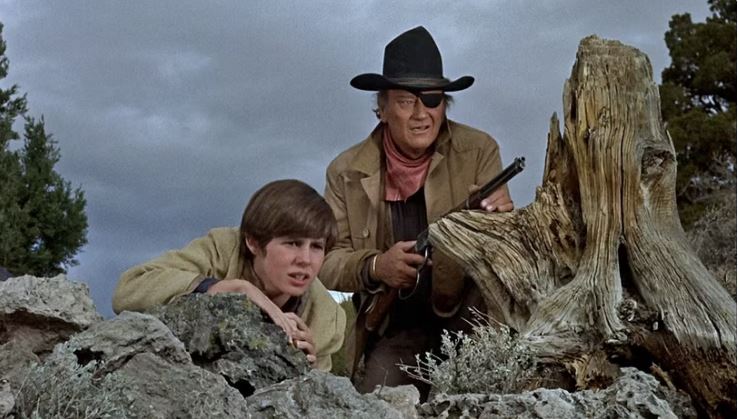
The Movie Also Represents the Dangers of Vanity in Cinema
The loss of the novel’s darkness and themes also might be why cinephiles best remember True Grit as an homage to Wayne, not a great Western. By 1969, the cultural zeitgeist had shifted, and audiences that once flocked to Wayne’s cowboy movies had started to drift elsewhere. Mike Nichols’ film, The Graduate, ushered in a new era of sexual frankness in popular movies, and nodded to the moral questions that young people — the Baby Boomer generation — had started to wrestle with. Dennis Hopper, who has a small role as one of Pepper’s gang members here, directed Easy Rider, which also hit cinemas in 1969. The latter introduced explicit drug use to movies as well as the specter of the Vietnam War.
These movies marked the beginning of the New Hollywood movement, which was the rejection of the artifice that was synonymous with Hollywood’s Golden Age, of which Wayne was a part of. Subjects like sex, internal darkness, and then-current events had a much deeper value to viewers. As well-made as it may be, a feel-good Wayne vehicle just didn’t have the same resonance anymore. The ’60s were some of the darkest years in American history, and seeing Wayne save the day didn’t speak to the moment. It didn’t help that True Grit was more transparently focused on propping up Wayne’s legacy and ego. Comparing the relatively pristine look of True Grit with its classic backlot towns, rolling landscapes and manicured actors with the grime and dirt of Easy Rider exposes the former as an illusion. True Grit may be a good Western, but it has no authenticity.
Maybe because of this lack of authenticity, or maybe because Hathaway and Roberts converted True Grit from a dark story about a young girl to a celebration of Wayne, the Cohen Brothers decided to remake the film in 2010. The remake is the far superior version of the same story. It preserves the story as belonging to Mattie (now played by Steinfeld), as well as the darkness and violence of the original novel. Rather than a grinning cinematic hero waiting for one last adventure, Rooster Cogburn (played by Jeff Bridges), comes across as a Falstaff-like character: a fallen warrior, given way to age, drink, and flatulence. The West depicted in the remake comes off as less of a fantasy landscape than a corrupting Purgatory, contextualizing Mattie’s plight as feeling torn between justice and vengeance. It’s also possible to see the 1969 version of True Grit and not have every plot point of the 2010 version spoiled, so the less said about certain plot twists, the better.
True Grit Missed the Opportunity to Star a Deeper & Wiser John Wayne
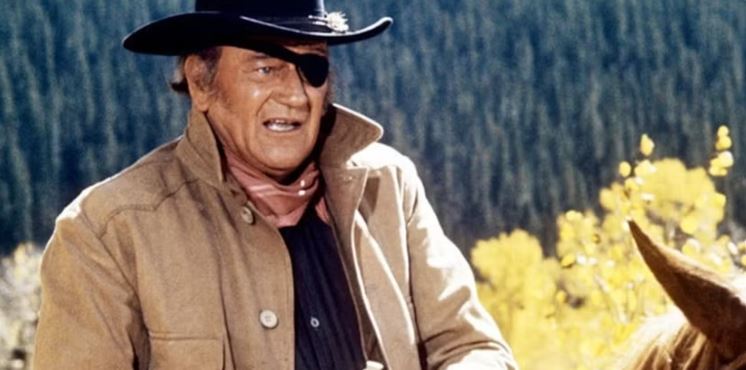
The Movie is Something Only For John Wayne Fans
Had Hathaway and Wayne set out to make a movie faithful to Portis’ novel and one that was less concerned with gilding Wayne’s image than telling a challenging story, they might have made a film for the ages. Wayne could have shined in a darker take on Rooster. An edgier Rooster would’ve been less glamorous and more flawed than Wayne’s previous characters, but such a role would also show his maturity as a person and growth as an artist. Keeping the story focused on Mattie would have also better showcased Darby’s fine work, and better yet, afforded her an even more dynamic role that could have cemented her place as a film star. Cinephiles can only wonder how much better True Grit and the rest of Wayne’s career could’ve been if different choices were made, and if alternatives were considered.
Today, True Grit has a certain nostalgic value, as it hearkens back to the days when Hollywood prioritized selling fantasies to audiences over challenging narratives. The movie, for all its hollowness, does still have plenty to enjoy, starting with a flamboyant performance by Wayne, and the quiet determination of Darby. Western fans will revel in seeing Wayne ride off as the triumphant cowboy, though they’ll have a hard time not feeling a bit melancholy too. True Grit symbolizes the end of an era, but not because it knew its time in the sun was done. Rather, it’s because of its refusal to acknowledge the changing times that True Grit feels as dated now as it did all the way back in 1969.
